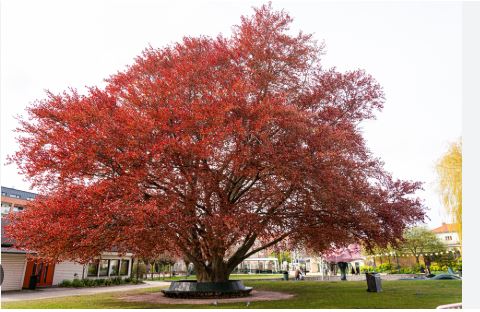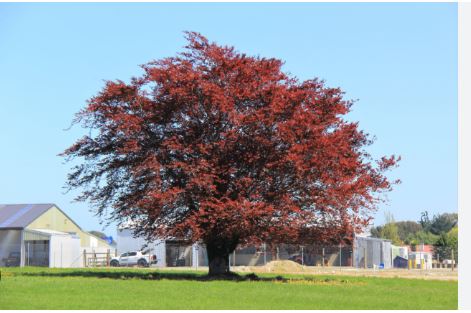
Beech trees, part of the Fagus genus, genus of about 10 species of deciduous ornamental and timber trees in the family Fagaceae native to temperate and subtropical regions of the Northern Hemisphere. They can grow to be quite tall, with mature trees reaching over 40 meters. Beech trees are also known for holding onto their dead leaves throughout the winter, a phenomenon called marcescence.
Beech trees are tall, round-headed, and wide-spreading. The thin bark is smooth and steel-gray in colour. The toothed parallel-veined leaves are shiny green and are borne alternately along the stem. Yellow-green male flowers hang from threadlike stems. The female flowers, usually in pairs on short hairy stems on the same tree, develop into prickly burs enclosing one or two three-sided sweet-flavoured nuts. Beeches grow best in sandy loam. They are slow-growing but may live 400 years or more. Propagation is usually by seed; the shallow spreading root system often sends up suckers that may grow into thickets.
Ecologically, beech trees are invaluable. Their extensive roots stabilize soil, preventing erosion, while their leaf litter nourishes the ground as it decomposes. They support diverse wildlife, from insects to mammals, and create shaded habitats for understory plants. In forests, they often dominate as stable, long-lived species, fostering balanced ecosystems through their presence.
Beech wood is highly valued for its strength and fine grain, used in furniture, flooring, and tools. In landscaping, these trees shine as focal points or hedges, with their foliage adaptable to pruning for formal designs. Their versatility makes them a favorite for both aesthetic and practical purposes, enhancing any outdoor space with elegance.

Types of Beech Trees
American Beech (Fagus grandifolia)
The American beech is characterized by its smooth, silver-gray bark, which often remains unblemished even in maturity, making it a standout in forests. Its leaves are ovate, with serrated edges, turning golden bronze in fall. The tree produces small, triangular nuts encased in spiny husks, favored by wildlife. It grows to 60–80 feet tall, with a broad, rounded crown. Native to eastern North America, it thrives in moist, well-drained soils from Nova Scotia to Florida and west to Texas, often dominating mixed hardwood forests in the Appalachian region.
European Beech (Fagus sylvatica)
This species has glossy, dark green, ovate leaves with wavy margins, turning a rich copper in autumn. Its bark is smooth and gray, and it produces beechnuts in prickly husks. Growing up to 100 feet, it has a dense, rounded canopy. Widely distributed across Europe, from southern Scandinavia to the Mediterranean, it prefers temperate climates and fertile, well-drained soils. It’s commonly planted as an ornamental tree and for hedging due to its ability to retain leaves in winter when pruned.
Japanese Beech (Fagus crenata)
Known as Buna in Japan, this beech has small, ovate leaves with finely toothed edges, turning yellow to bronze in fall. Its bark is smooth and gray, and it produces small, edible beechnuts. Reaching heights of 80–100 feet, it has a broad, spreading crown. Native to Japan, it dominates cool-temperate forests, particularly in Honshu, Hokkaido, and Shikoku, thriving in moist, acidic soils at elevations up to 6,000 feet. It’s a key species in Japan’s montane ecosystems.
Chinese Beech (Fagus engleriana)
This species features elongated, pointed leaves with serrated edges, turning golden yellow in autumn. Its bark is pale gray and smooth, and it produces small, triangular nuts. Growing to about 50–70 feet, it has a slender, upright form. Native to central and southern China, it is found in mixed forests at elevations of 3,000–8,000 feet, often in limestone-rich soils. It’s less common in cultivation but valued for its graceful structure in its native range.
Oriental Beech (Fagus orientalis)
The Oriental beech has large, ovate leaves with prominent veins and slightly toothed margins, turning yellow-brown in fall. Its bark is smooth and grayish, and it produces beechnuts in spiny husks. It can reach 100 feet with a dense, broad canopy. Native to the Caucasus, northern Iran, and parts of Turkey, it grows in mountainous regions at 1,600–7,000 feet, favoring moist, well-drained soils. It’s often used in reforestation in its native range.
Taiwan Beech (Fagus hayatae)
This smaller beech, reaching 30–50 feet, has narrow, lance-shaped leaves with finely serrated edges, turning yellow in fall. Its bark is smooth and light gray, and it produces small beechnuts. Endemic to Taiwan, it grows in montane forests at elevations of 4,000–7,000 feet, often in foggy, humid conditions. Its restricted distribution makes it less known, but it’s a key component of Taiwan’s high-altitude ecosystems, thriving in acidic, rocky soils.
Mexican Beech (Fagus mexicana)
This rare species has small, ovate leaves with toothed margins, turning golden in autumn. Its bark is smooth and gray, and it produces small, edible nuts. Growing to 60–80 feet, it has a narrow, upright form. Found only in eastern Mexico, particularly in cloud forests of Hidalgo and Puebla, it thrives at 4,000–6,500 feet in humid, misty conditions. Its limited range makes it vulnerable to habitat loss, but it’s culturally significant in local ecosystems.
Crimean Beech (Fagus taurica)
A close relative of the European beech, this species has ovate, glossy leaves with wavy margins, turning reddish-brown in fall. Its bark is smooth and gray, and it produces beechnuts in prickly husks. It grows to 80–100 feet with a broad crown. Native to Crimea and parts of the Black Sea coast, it thrives in temperate, mountainous regions at 2,000–6,000 feet, often in mixed forests with oaks and pines, preferring well-drained, loamy soils.
Fagus lucida (Shiny Beech)
Native to southern China, this species is named for its glossy, dark green leaves, which are ovate with finely toothed edges and turn yellow in fall. Its bark is smooth and pale gray, and it produces small beechnuts. Growing to 50–70 feet, it has a compact, rounded crown. It’s found in subtropical and temperate forests at 3,000–7,000 feet, often in limestone areas of Guangdong and Hunan. It’s less common in cultivation but valued for its lustrous foliage.
Fagus longipetiolata (Long-Petioled Beech)
This Chinese species is distinguished by its long leaf stalks and ovate, serrated leaves, which turn golden-yellow in autumn. Its bark is smooth and gray, and it produces small nuts in spiny husks. Reaching 60–80 feet, it has a broad, open canopy. Native to southern and eastern China, it grows in mixed forests at 2,000–6,000 feet, favoring moist, fertile soils. It’s occasionally planted ornamentally for its distinctive foliage.
Copper Beech (Fagus sylvatica ‘Purpurea’)
A cultivar of the European beech, the copper beech is prized for its deep purple or coppery leaves, which are ovate with wavy margins and retain their color through summer before turning bronze in fall. Its bark is smooth and gray. Growing to 70–100 feet, it has a dense, rounded crown. Widely planted as an ornamental across Europe and North America, it thrives in temperate climates with well-drained soils, often used in parks and estates.
Weeping Beech (Fagus sylvatica ‘Pendula’)
Another European beech cultivar, the weeping beech has cascading branches and dark green, ovate leaves that turn golden in autumn. Its bark is smooth and silver-gray, and it produces small beechnuts. It grows to 50–70 feet with a distinctive drooping form. Popular in ornamental landscaping in Europe and North America, it prefers fertile, well-drained soils in temperate regions and is often a focal point in gardens due to its graceful structure.
Dawyck Beech (Fagus sylvatica ‘Dawyck’)
This columnar cultivar of the European beech has a narrow, upright form, reaching 50–80 feet. Its leaves are dark green, ovate, and turn yellow-brown in fall, with smooth, gray bark. It produces small beechnuts. Widely planted in Europe and North America for its architectural shape, it thrives in temperate climates with well-drained soils. Its distribution is primarily ornamental, used in avenues and formal gardens.
Fernleaf Beech (Fagus sylvatica ‘Aspleniifolia’)
Known for its finely cut, fern-like leaves, this European beech cultivar has deeply lobed, dark green foliage that turns golden in fall. Its bark is smooth and gray, and it produces small nuts. Growing to 50–70 feet with a broad, rounded crown, it’s a popular ornamental in Europe and North America, thriving in temperate, well-drained soils. Its unique leaf shape makes it a standout in landscapes.
Fagus japonica (Japanese Blue Beech)
This species has smaller, ovate leaves with a bluish-green hue and finely toothed edges, turning yellow in fall. Its bark is smooth and gray, and it produces small beechnuts. Growing to 50–70 feet, it has a rounded canopy. Native to Japan, it’s found in mixed forests on Honshu and Kyushu, often at 2,000–5,000 feet in moist, acidic soils. It’s less common than Fagus crenata but valued for its subtle leaf coloration.
Why Choose Beech Trees for Your Landscape?
Beech trees are versatile, offering aesthetic appeal, shade, and ecological benefits. Their smooth bark, vibrant foliage, and adaptability to various climates make them ideal for parks, gardens, and urban settings. Here are a few reasons to plant beech trees:
- Ornamental Beauty: From purple foliage to weeping branches, beech trees add visual interest year-round.
- Wildlife Support: Beechnuts provide food for birds, squirrels, and other wildlife.
- Durability: Beech wood is strong and used in furniture, flooring, and cabinetry.
- Shade: Their dense canopies create cool, shaded areas perfect for outdoor spaces.